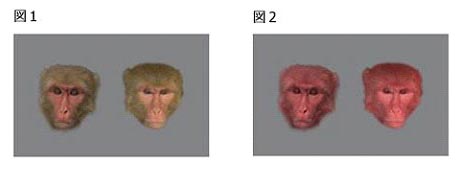News
Kyushu University Found Primate Eyes Can Easily Detect Facial Complexion Updated in July 2017
There is an expression "reading faces." That is, to guess someone’s thoughts from their facial expressions. Interestingly, it seems that primates’ eyes are made to easily detect differences in complexion. Group led by Chihiro Hiramatsu, a Kyushu University Research Associate announced recently.
In primates’ eyes, there are three kinds of cells that are sensitive to the colors "blue" "green" and "red". By processing which cells are reacting well to a certain color, the brain judges which color it is seeing. However, among them, cells responding to green have a characteristic that are more likely to respond to reddish green rather than the traditional “green” color. Dr. Hiramatsu and her team thought that this characteristic may help primates to better distinguish subtle differences in facial coloration.
Dr. Hiramatsu prepared two images of a rhesus monkey with different facial coloring. They are photos of a female rhesus monkey’s face during breeding season, and a picture of the same monkey under normal conditions. The face during breeding period is redder and darker. She prepared two types of pictures. One is a picture reflecting the monkey’s true complexion (Diagram 1). The other is a pseudo-image created in assumption that the observer will react more to the traditional “green” color rather than reddish green (Diagram 2). The group presented these two types of images to 20 human observers (male and female) and asked them to instantly select the monkey going through breeding period.
As a result, the percentage of correct answers declined significantly when the pseudo-images were shown. Besides, it took a long time for the subjects to judge. It can be concluded that eye cells peculiar to primates, help them to accurately capture differences in facial coloring.
Many mammals judge colors with two kinds of cells: "blue" and "red." In case of primates, it has been pointed out that it is easier for them to distinguish red fruits from green leaves after they developed such green-detecting cells. In Dr. Hiramatsu's research, it became clear that these unique green-detecting cells are also useful for "reading face" and for communicating socially.

Photos courtesy of Japan Science and Technology Agency







